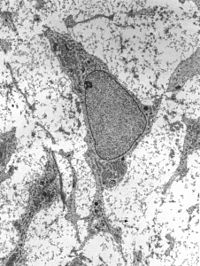
Photo from wikipedia
In this introductory chapter, we describe male germline development in plants taking Arabidopsis thaliana as a reference species. We first describe the transition from sporophytic to germline development, then microsporogenesis… Click to show full abstract
In this introductory chapter, we describe male germline development in plants taking Arabidopsis thaliana as a reference species. We first describe the transition from sporophytic to germline development, then microsporogenesis including meiosis, followed by male gametophyte development prior to pollination, and finally the progamic phase culminating in double fertilization, which leads to the formation of the embryo and the endosperm. For detailed information on some of these processes or on the molecular underpinning of certain fate transitions, we refer the reader to recent reviews. An important but often neglected aspect of male gametophyte development is the formation of the unique pollen cell wall. In contrast to that of other plant cells, the pollen cell wall is composed of two principal layers, the intine and exine. While the intine, the inner pecto-cellulosic cell wall layer, is biochemically and structurally similar to a "classical" plant cell wall, the exine is a unique composite with sporopollenin as its main component. Biosynthesis of the cell wall is remarkably similar between the spores of mosses and ferns, and pollen of seed plants, although slight differences exist, even between closely related species (reviewed in Wallace et al., AoB Plants 2011:plr027, 2011). In the latter sections of this chapter, we will present a brief overview of cell wall development in Arabidopsis pollen, where this aspect has been intensively studied.
Journal Title: Methods in molecular biology
Year Published: 2017
Link to full text (if available)
Share on Social Media: Sign Up to like & get
recommendations!